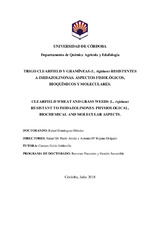Mostrar el registro sencillo del ítem
Trigo Clearfield y gramíneas (L. rigidum) resistentes a imidazolinonas. Aspectos fisiológicos, bioquímicos y moleculares
| dc.contributor.advisor | Prado Amián, Rafael de | |
| dc.contributor.advisor | Rojano Delgado, Antonia M. | |
| dc.contributor.author | Domínguez Méndez, Rafael | |
| dc.date.accessioned | 2018-10-08T09:13:09Z | |
| dc.date.available | 2018-10-08T09:13:09Z | |
| dc.date.issued | 2018 | |
| dc.identifier.uri | http://hdl.handle.net/10396/17215 | |
| dc.description.abstract | El control de malas hierbas en trigo es uno de los principales objetivos de los agricultores para obtener mayores rendimientos, este manejo sin el uso de herbicidas es inconcebible en los sistemas convencionales de producción intensiva de trigo. Por ello, los cultivos resistentes a herbicidas ofrecen ventajas significativas para el control de malezas. En este trabajo se caracterizó el nivel de resistencia a imazamox de dos nuevas variedades de trigo llamadas Rafalín (T. aestivum) y Antoñín (T. durum), que se obtuvieron por mejoramiento convencional mediante tecnología Clearfield®. Además, se definieron los rasgos que confieren resistencia múltiple a imazamox + glufosinato de dos líneas de T. aestivum (Anza y Pantera). Los cultivares de T.aestivum se compararon con la variedad sensible Gazul, mientras que el cultivar de T.durum se realizó con su homólogo sensible Simeto. Los cultivares R fueron 93,7 (Rafalín) y 43,7 (Antoñín) veces más resistentes a imazamox, del mismo modo, Anza y Pantera fueron 15.1 y 27,9, respectivamente más resistentes a imazamox + glufosinato que sus respectivos cultivares S. La actividad de la enzima ALS reveló una alta resistencia a los herbicidas imidazolinonas (IMI) en cultivares R. La mutación Ser 653Asn que confiere resistencia a los herbicidas IMI se identificó en los genes imi1 e imi2 de Rafalín y Pantera y sólo en el gen imi1 de Antoñín y Anza. La enzima GS de las plantas de trigo R y S fue igualmente sensible a glufosinato. Sin embargo, las plantas R presentaron una baja acumulación de amonio debido a la acetilzación rápida del glufosinato a N-acetil-glufosinato por la enzima PAT, adquirida de la proteína parental resistente a glufosinato. Los patrones de absorción de 14Cimazamox y 14C-glufosinato fueron similares entre los cultivares R y S, mostrando que estos parámetros no estaban implicados en la resistencia. La diferencia de sensibilidad entre cultivares R (Rafalín y Antoñín) se debió a la cantidad de genes de resistencia que portan cada genotipo. Igualmente, la resistencia múltiple a imazamox + glufosinato encontrada en Anza y Pantera se debieron a alteraciones en el gen ALS y a una inactivación rápida del glufosinato a N-acetil-glufosinato. Por lo que los cultivares R podrían ser una excelente herramienta de control de malezas en la producción de trigo. | es_ES |
| dc.description.abstract | The control of weeds in wheat is one of the main objectives of farmers to obtain higher yields, this management without herbicide use is not conceivable in conventional intensive wheat production systems. Therefore, herbicide resistant crops offer significant advantages to weed control. In this work, the resistance level to imazamox of two new varieties of wheat called Rafalín (T. aestivum) and Antoñín (T. durum), that were obtained by conventional breeding using Clearfield® technology, was characterized. In addition, the stacked traits that conferring multiple resistance to imazamox + glufosinate of two lines of T. aestivum (Anza and Pantera) were defined. The cultivars of T.aestivum were compared with the susceptible variety Gazul, while the cultivar of T.durum was made with its sensitive counterpart Simeto. The R cultivars were 93.7-fold (Rafalin) and 43.7- fold (Antoñín) more resistant to imazamox, similarly, Anza and Pantera were 15.1 and 27.9, respectively more resistant to imazamox + glufosinate than their respective S cultivars. The acetolactate synthase (ALS) enzyme activity revealed high resistance to imidazolinone (IMI) herbicides in R cultivars. The Ser653Asn mutation that confers resistance to IMI herbicides was identified in the imi1 and imi2 genes of Rafalin and Pantera and only in the imi1 gene of Antoñín and Anza. The GS enzyme of R and S wheat plants was equally sensitive to glufosinate. However, the R plants exhibited low ammonia accumulation due to the rapid acetylation of glufosinate to N-acetyl-glufosinate by the PAT enzyme, acquired from it glufosinate-resistant parent. The similar absorption patterns of 14C-imazamox and 14C-glufosinate between R and S cultivars showed that these parameters were not involved in the resistance. The differential sensitivity between R cultivars (Rafalin and Antoñín) was due to the number of resistance genes that carry each genotype. Likewise, the multiple resistance to imazamox + glufosinate found in Anza and Pantera were due to alterations in the ALS gene and a rapidly inactivation the glufosinate to N-acetyl-glufosinate. The R cultivars could be excellent weed control tool in wheat production. | es_ES |
| dc.format.mimetype | application/pdf | es_ES |
| dc.language.iso | spa | es_ES |
| dc.publisher | Universidad de Córdoba, UCOPress | es_ES |
| dc.rights | https://creativecommons.org/licenses/by-nc-nd/4.0/ | es_ES |
| dc.subject | Gramíneas | es_ES |
| dc.subject | Trigo Clearfield | es_ES |
| dc.subject | Control de malas hierbas | es_ES |
| dc.subject | Herbicidas | es_ES |
| dc.subject | Imidazolinonas | es_ES |
| dc.subject | Mecanismos de resistencia | es_ES |
| dc.title | Trigo Clearfield y gramíneas (L. rigidum) resistentes a imidazolinonas. Aspectos fisiológicos, bioquímicos y moleculares | es_ES |
| dc.title.alternative | Clearfield wheat and grass weeds (L. rigidum) resistant to imidazolinones. Physiological, biochemical and molecular aspects | es_ES |
| dc.type | info:eu-repo/semantics/doctoralThesis | es_ES |
| dc.rights.accessRights | info:eu-repo/semantics/openAccess | es_ES |

